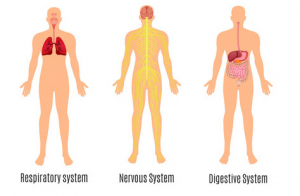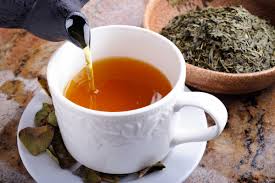Everyone knows that our lungs are the major organ in our respiratory system, that our brain is central to our nervous system and that our stomach and intestines are partners in our digestive system.

How does that connect to organizing? Just look at the word: there is an ORGAN inside organizing!
Our bones — amazing organs within our skeletal system — form the structure of our bodies while they protect our internal organs. With the help of ligaments and tendons, our skeletal system allows us to move.
 Let’s look at our households like our bodies — and see ORGANizing from an interdependent, systemic perspective:
Let’s look at our households like our bodies — and see ORGANizing from an interdependent, systemic perspective:
• providing structure and support
• filtering toxins (clutter)
• creating space for nourishment
• allowing time to digest our days
• minimizing distractions
As the daughter of a D.O., the osteopathic approach always takes the whole person into consideration. Likewise, I consider the whole household when organizing.
 On that note, let’s all head into 2019, protecting our:
On that note, let’s all head into 2019, protecting our:
• organizing time like our brains
• organizing framework as we maintain our posture
• organizing schedule as routinely as brushing our teeth
• and use our ORGANizing muscles to stay healthy!
Happy New Year
I used to think I was very clever whenever I advised people about gift giving for special occasions and holidays. I would always suggest that when selecting gifts for people who actually have material plenty to give beautiful “disposables.” I observed that wonderful self-destructive options abound: wines, beautiful candles, delightful oils, luscious baked goods and candies, elegant lotions, fancy soaps…You see what I mean. And they don’t last forever! What a great idea!
Then, I started to discover that many of my clients – people who were trying their best to de-clutter – were given so many of the very disposables I routinely suggested that I couldn’t imagine how many lifetimes would be needed to use up all these treasures. It is possible to overdo absolutely anything.
So, what to do?? Depending on the closeness of the relationships, perhaps some frank discussions are possible. Can your entire extended family happily agree to pool money and go somewhere really special? Would treating someone to a lovely dinner or show be a delightful novelty? Someone else might love a membership or a day at the zoo or a favorite museum. Maybe the whole family would chip in to hire a chef or caterer to create a marvelous holiday dinner, so no one has the stress of cooking, hosting, or cleanup.

This year, really think about and talk about your gifts. So many of us are truly overloaded with objects, but would benefit from a certificate for a manicure, a massage, dog-walking services, baby-sitting, or perhaps a lovely outing to a tea shop for a long talk with you.
There are also gift cards and certificates for companies where your friend or relative will truly benefit from some extra freedom to choose something they need. One of my clients was actually given a generous check made out to her Professional Organizer! Moved by the friend’s thoughtfulness, the organizer (me) gave the client extra time.
Especially in the midst of all the natural disasters surrounding us, would your loved ones be thrilled (and relieved) if you made a charitable donation in their honor?
You can see where I’m going with this: make this a year of thinking outside the box with gifts that don’t go in a box at all. The key to success with these plans is the gift of intimacy, your shared comfort in discussing your true preferences, ideas, and suggestions.
Happy Holidays!
Spring is finally springing up all around us, daffodils are blooming and the forsythia is blossoming into that amazing yellow color.
Easter and Passover are a time of new beginnings. April is also the month we celebrate the earth. Earth Day began in Philadelphia in 1970 (Belmont Plateau anyone?). In the organizing and productivity industry, we consider every day Earth Day! When we work with clients on a home organizing project, we teach our clients about recycling. There is so much that we recycle to help preserve our earth. Here are some of the resources that we use to locate the most appropriate place to donate and recycle in our area:
However currently there is an abundance of stuff that people are getting rid of, they are very picky, so what you try to consign has to be in very good condition.
Depending on what you have there is usually an auction house or specialty sale that items can go to. When you sell at auction houses and consignment shops there is a fee usually between 30% and 50%.
The answer to the question is yes. According to the Mayo Clinic, hoarding disorder is “a persistent difficulty discarding or parting with possessions because of a perceived need to save them.” Those who hoard have difficulty parting with possessions even if those possessions are of little or no value. This behavior can affect the emotional, physical, social and financial status of the individual and their family. Commonly hoarded items may be house hold items, newspapers, magazines, paper or plastic bags, boxes, photos, food or clothing. Hoarding is a disorder that may exist on its own or in conjunction with other health disorders. Obsessive compulsive disorder, obsessive compulsive personality, disorder attention deficit disorder and depression are often linked with hoarding. There is often a feeling of shame and embarrassment associated with hoarding.
Symptoms include: Significant anxiety when attempting to discard items. Obtaining and saving large amounts of items. Difficulty to organize items with items overtaking rooms of the home. Indecision about what items should be kept and what items should be discarded. Mental and emotional distress or overwhelm regarding the amount of items in the home. Fear of running out of an item and not having that item on hand in the future.
Loss of living space, social isolation, family discord, health and safety hazards.
The results: Items such as newspapers or magazies, clothing, bags of food or books crowd rooms, pathways and common areas of the home minimizing the functional use of the space and increasing the safety risks in the home. Those with hoarding disorder often experience distress or conflict at the suggestion of de cluttering or discarding hoarded items. Hoarding decreases the ability for an individual or family to maintain order and may cause rifts among family
Why do people hoard? It is not exactly clear what causes hoarding disorder. Perhaps genetics or parental influences or certain patterns in the brain. Stress may have an influence as well as emotional distress from loss of a loved one or pet. Other reasons include the belief that items are special or hold more monetary value then is realistic. Some are paralyzed at the thought of throwing items away for fear they are “wasting”. Certain items hold emotional value or serve as a reminder of the good days gone by. And some feel a sense of safety when surrounded by all the items that make up their hoard.
If you suspect you or a loved one have a problem with hoarding, it is best to seek professional help. Look for a therapist who specializes in hoarding situations. In some cases, an intervention is needed to ensure the safety of children or the elderly. After seeking the help of a therapist, a professional organizer is a great asset and can assist in collaboration with family members and other professionals to help guide the client to a more fulfilling and safer way of living.

As I lay in bed for a week from an illness this summer, I took the time to write this article for the NAPO-GPC blog. Even getting ill didn’t stop me from getting things done. I knew the deadline was quickly approaching so I decided to write about getting ill! Here are a few tips for how to organize yourself or help out a friend when stuck in bed.
 the house for me so I could stay hydrated. Chamomile tea in the den. Peppermint tea in the kitchen, drinks in my bedroom and water in my bathroom. I do not mind room temperature drinks but if you need yours cold/hot there are some wonderful thermal drinking vessels out there.
the house for me so I could stay hydrated. Chamomile tea in the den. Peppermint tea in the kitchen, drinks in my bedroom and water in my bathroom. I do not mind room temperature drinks but if you need yours cold/hot there are some wonderful thermal drinking vessels out there.My other advice would be, don’t get sick in the summer! What a bummer! I totally missed a huge rain storm. While everyone else was panicking, I was sound asleep. I missed some beautiful sunny days and God knows what was going on in my garden. I hope you stay well, but if you do feel terrible try these tips to help you stay on track.
Life in the 21st century is anything but simple. Our world feeds us countless messages defining what we need in order to be happy, successful, and fulfilled. We’ve all heard these messages, either directly or indirectly, and we’ve all bought into at least some of the hopeful promises that our lives can improve…if only we [you fill in the blank].
But the true result of our modern life, trying to keep up with our packed schedules, overflowing to-do lists, and material abundance is sadly, not satisfaction and peace. Rather, we have stress, anxiety, broken relationships, and a LOT of stuff.
So, in the complexity of our technological age, what does it mean to simplify? What does a simpler life look like for an ordinary family keeping up with work, school, and countless demands? Regardless of the season of life—a young couple, family with children, or empty nesters—how can any of us find a greater level of simplicity in our noisy, chaotic, energetic world?
The beautiful truth is that the concept of “living simply” looks different for each person and every family. What I deem a simpler, less complicated life for my family will undoubtedly look different from your ideal. The challenge is that it takes effort to figure out how to step out of a cluttered and demanding lifestyle to pursue a more balanced and satisfying experience of daily life.
I want to highlight the two qualities that define a simpler life, according to Deborah DeFord in her book, The Simpler Life (The Readers Digest Association, Inc, 1998). These are integrity and intentionality.
Integrity is defined as a state of being whole and undivided. This ideal means I need to look at what is important to me, and then live according to those goals and values. If I believe physical fitness is important but never make time in my week to get up and move, then I am not living an integrated life. Rather, to live according to what I value, I will commit to walking 3 times each week and schedule it on my calendar. It’s as simple as that: Live in accordance with what is important to you.
Intentionality means we act with purpose. We consciously decide the choices we make throughout our day. Thus, to be intentional requires a certain mindfulness. If we are always “going with the flow,” we may feel spontaneous, but we are not in control of our day. We are reacting rather than being proactive. I must admit that I sometimes fell prey to impulse purchases, buying things because they were on sale, even though they were not items on my list. The result was I spent money I hadn’t planned to spend, brought home things I might not actually use, and then had to find a place to store my latest bargains. Learning to live with intention means pausing to evaluate my true needs.
How will pursuing integrity and intentionality help you lead a simpler life?
Only you can decide what is most important to you. Only you can be in control of the way you spend your time, the things you buy, and the relationships you pursue. When you proactively make decisions on what you need in your life and shut out the noise of what others are proclaiming, you will have the ability to pursue only those people, activities and things that give meaning to your life. Saying “no” to the unnecessary is saying “yes” to what is most valuable—which leads to true satisfaction, contentment, and peace.